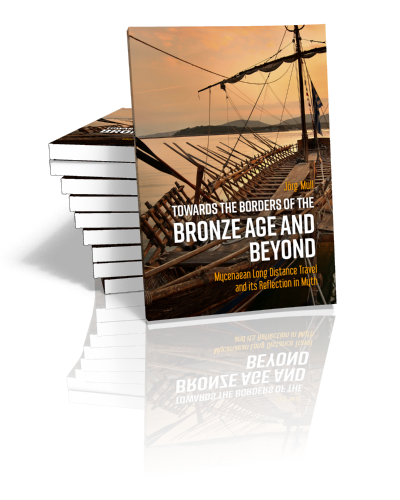Paperback ISBN: 9789464260779 | Hardback ISBN: 9789464260786 | Imprint: Sidestone Press | Format: 182x257mm | 162 pp. | Language: English | 2 illus. (bw) | 21 illus. (fc) | Keywords: Late Bronze Age; metal trade; exploration; myths; Mycenaean long-distance travel; Ancient Greece; Greek mythology; archaeology; seafaring; Mediterranean Sea | download cover
The Late Bronze Age from about 1600 to 1150 BCE was a time of unprecedented economic activity in human history based on the supply and production of the eponymous alloy bronze on an almost industrial scale. The supply networks for copper and tin during this period stretched over large parts of western Eurasia and included long distance maritime transport.
The palatial centres of Mycenaean Greece were positioned at a unique geographical interface between the cultural hotspots of the eastern Mediterranean as well as the metal supply sources in the western Mediterranean, northern Europe and the Black Sea area. There are archaeological and historical indications that Mycenaeans somehow contributed either directly or indirectly via intermediaries to the exchange of goods in the second half of the 2nd millennium BCE. However, and partially due to limitations of archaeological and historical evidence, the degree to which the Mycenaean Greeks conducted long distance commercial journeys themselves to participate in the metal trade of the period is still disputed.
Mull analyses the large corpus of the Greek myths, some of which are likely to go back to Bronze Age roots and which contain evidence of long distance journeys of Mycenaean pioneering adventurers. Mull, after an education in classical languages, became a trained economist with almost 30 years of experience in international business. From this unusual vantage point he provides a fresh perspective on what is known about travel and trade during the Late Bronze Age, a discipline so far dominated by archaeologists and historians.
1. Preface
2. Introduction
3. References to Time and Dates in the Bronze Age
4. The Historical and Archaeological Framework of Travel and Mobility in the Bronze Age
5. The Economic Background of Bronze Age Long Distance Travel
6. Shipbuilding in the Bronze Age
7. Evidence for Mycenaean Long Distance Journeys in the LBA
8. Reflections of Mycenaean Long Distance Travel in the Mythological Record
8.1 Definition, Structures and Functions of Myth
8.2 Myth and History
8.3 Genealogies – Mythical Timekeeping
8.4 The Content and Narrative Style of Greek Travel Myths
8.5 The Historicity of Greek Travel Myths9. Mycenaean Contacts with the Civilizations in the Eastern Mediterranean
9.1 Mycenaean Contacts with Anatolia
9.1.1 Archaeological and Historical Evidence of Mycenaean Contacts with Anatolia
9.1.2 Reflections in Greek Myths
9.2 Mycenaean Contacts with the Levant
9.2.1 Archaeological Evidence of Mycenaean Contacts with the Levant
9.2.2 Reflections in Greek Myths
9.3 Mycenaean Contacts with Cyprus
9.3.1 Archaeological Evidence of Mycenaean Contacts with Cyprus
9.3.2 Reflections in Greek Myths
9.4 Mycenaean Contacts with Egypt
9.4.1 Pictorial, Historical and Archaeological Evidence of Mycenaean Contacts with Egypt
9.4.2 Reflections in Greek Myths10. Mycenaean Contacts with the Central and Western Mediterranean
10.1 Evidence of Mycenaean Journeys to Italy and Sicily
10.1.1 Archaeological Evidence
10.1.2 Reflections in Greek Myths
10.2 Evidence of Mycenaean Contacts with Sardinia
10.2.1 Archaeological Evidence
10.2.2 Reflections in Greek Myths
10.3 Evidence of Mycenaean Contacts with the Iberian Peninsula
10.3.1 Archaeological Evidence
10.3.2 Reflections in Greek Myths11. Mycenaean Journeys to the Black Sea Area
11.1 The Historical, Archaeological and Epigraphic Evidence for Mycenaean Contacts to the Black Sea Area
11.2 Reflections of Mycenaean Journeys with the Black Sea Area in Greek Myths12. The Mysterious Countries ‘Beyond’
12.1 The Far South and East – The Ethiopians, the Red Sea and the Indian Ocean
12.2 The Far West – The ‘Isles of the Blessed’
12.3 ‘Hyperborea’ – The Mysterious ‘Far North’
12.3.1 The Archaeological Evidence of Contacts from Mycenaean Greece with Northern Europe
12.3.2 The Mythical Record of Mycenaean Contacts with Northern Europe13. Summary and Conclusions
14. References






No comments:
Post a Comment